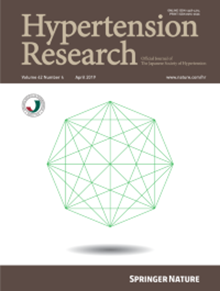Epigenomics and transcriptomics association study of blood pressure and incident diagnosis of hypertension in twins
IF 4.3
2区 医学
Q1 PERIPHERAL VASCULAR DISEASE
引用次数: 0
Abstract
Hypertension is the most frequent health-related condition worldwide and is a primary risk factor for renal and cardiovascular diseases. However, the underlying molecular mechanisms are still poorly understood. To uncover these mechanisms, multi-omics studies have significant potential, but such studies are challenged by genetic and environmental confounding – an issue that can be effectively reduced by studying intra-pair differences in twins. Here, we coupled data on hypertension diagnoses from the nationwide Danish Patient Registry to a study population of 740 twins for whom genome-wide DNA methylation and gene expression data were available together with measurements of systolic and diastolic blood pressure. We investigated five phenotypes: incident hypertension cases, systolic blood pressure, diastolic blood pressure, hypertension (140/90 mmHg), and hypertension (130/80 mmHg). Statistical analyses were performed using Cox (incident cases) or linear (remaining) regression analyses at both the individual-level and twin pair-level. Significant genes (p < 0.05) at both levels and in both types of biological data were investigated by bioinformatic analyses, including gene set enrichment analysis and interaction network analysis. Overall, most of the identified pathways related to the immune system, particularly inflammation, and biology of vascular smooth muscle cell. Of specific genes, lysine methyltransferase 2 A (KMT2A) was found to be central for incident hypertension, ataxia-telangiectasia mutated (ATM) for systolic blood pressure, and beta-actin (ACTB) for diastolic blood pressure. Noteworthy, lysine methyltransferase 2A (KMT2A) was also identified in the systolic and diastolic blood pressure analyses. Here, we present novel biomarkers for hypertension. This study design is surprisingly rare in the field of hypertension. We identified biological pathways related to vascular smooth muscle cells and the immune system, particular inflammation, to be associated with hypertension and blood pressure. Of specific genes, we identified KMT2A (lysine methyltransferase 2A) to be central for blood pressure and hypertension development. Abbreviations: ACTB: beta-actin, ATM: ataxia-telangiectasia mutated, BP: blood pressure, EWAS: epigenome-wide association studies, KMT2A: lysine methyltransferase 2A, LMER: linear mixed effect regression, LR: linear regression, TWAS: transcriptome-wide association studies.

双胞胎血压与高血压事件诊断的表观基因组学和转录组学关联研究。
高血压是世界范围内最常见的健康相关疾病,是肾脏和心血管疾病的主要危险因素。然而,潜在的分子机制仍然知之甚少。为了揭示这些机制,多组学研究具有巨大的潜力,但这类研究受到遗传和环境混杂的挑战——通过研究双胞胎的对内差异可以有效地减少这一问题。在这里,我们将来自丹麦全国患者登记处的高血压诊断数据与740对双胞胎的研究人群相结合,这些双胞胎的全基因组DNA甲基化和基因表达数据以及收缩压和舒张压测量数据都是可用的。我们研究了五种表型:高血压病例、收缩压、舒张压、高血压(140/90 mmHg)和高血压(130/80 mmHg)。在个体水平和双胞胎水平上使用Cox(事件病例)或线性(剩余)回归分析进行统计分析。显著基因(p)
本文章由计算机程序翻译,如有差异,请以英文原文为准。
求助全文
约1分钟内获得全文
求助全文
来源期刊

Hypertension Research
医学-外周血管病
CiteScore
7.40
自引率
16.70%
发文量
249
审稿时长
3-8 weeks
期刊介绍:
Hypertension Research is the official publication of the Japanese Society of Hypertension. The journal publishes papers reporting original clinical and experimental research that contribute to the advancement of knowledge in the field of hypertension and related cardiovascular diseases. The journal publishes Review Articles, Articles, Correspondence and Comments.
 求助内容:
求助内容: 应助结果提醒方式:
应助结果提醒方式:


